-

06 // Pressetexte # 01 Samui, 2008
32. Bremer Förderpreis für Bildende Kunst 2008Städtische Galerie im Buntentor / BremenJury statement on the awarding of the prize (02.02.09):Preechaya Siripanich's work "Samui" (2008) convinces through combinations of sculptural elements in the overall installation context. The artist combines situations of tradition with consciously ironic-melancholic traits. Creates model-like situations of compositional density, but does not lose sight of the simple simplicity and rudimentary. His works deal with aspects of longing, home, consumption, urban contexts and associated values, but always address the contradictions of everyday life and transform them into abstract, poetic contexts.
The Jury:
Leonie Baumann, Neue Gesellschaft für Bildende Kunst (NGBK), Berlin
Dr.Brigitte Franzen, Ludwig Forum für Internationale Kunst, Aachen
Dr. Gregor Jansen, ZKM / Museum für Neue Kunst, Karlsruhe
René Zechlin, Kunstverein Hannover -

01 // Arbeiten 2006 # 01 Das Zelt, deep-frozen bag, plaster, washing powder, 130 x 200 x 90 cm
-

01 // Arbeiten 2006 # 05 BrePark, cardboard, wooden plate, metal, fish cans, 140 x 125 x 50 cm
-

01 // Arbeiten 2006 # 06 BrePark (detail)
-

01 // Arbeiten 2006 # 07 no title, cardboard, wooden plate, metal, fish cans, 140 x 125 x 50 cm
-
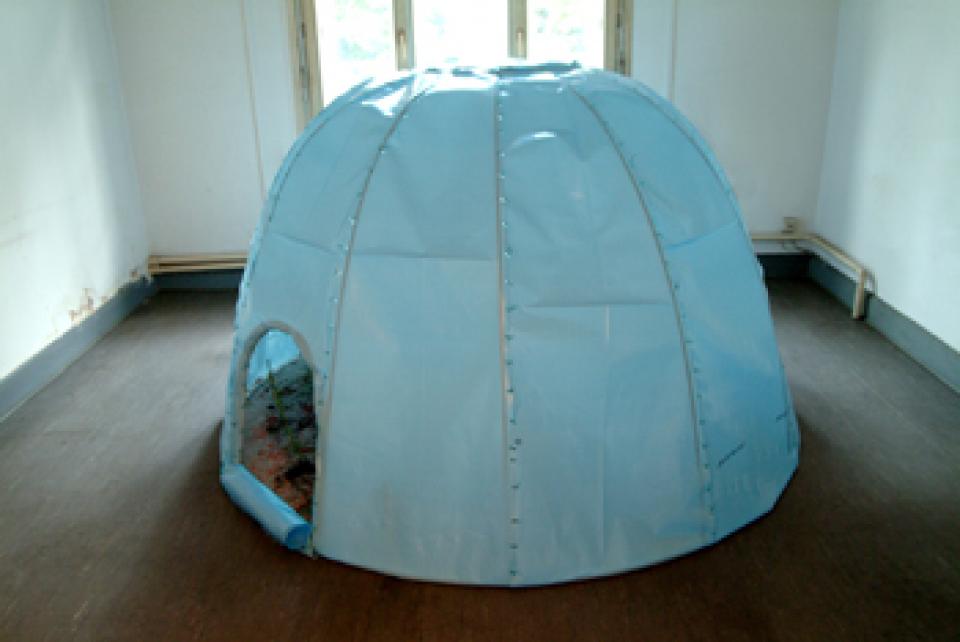
01 // Arbeiten 2006 # 08 Iglu, building foils, wood, natural material, plants, 250 x 250 x 150 cm
-
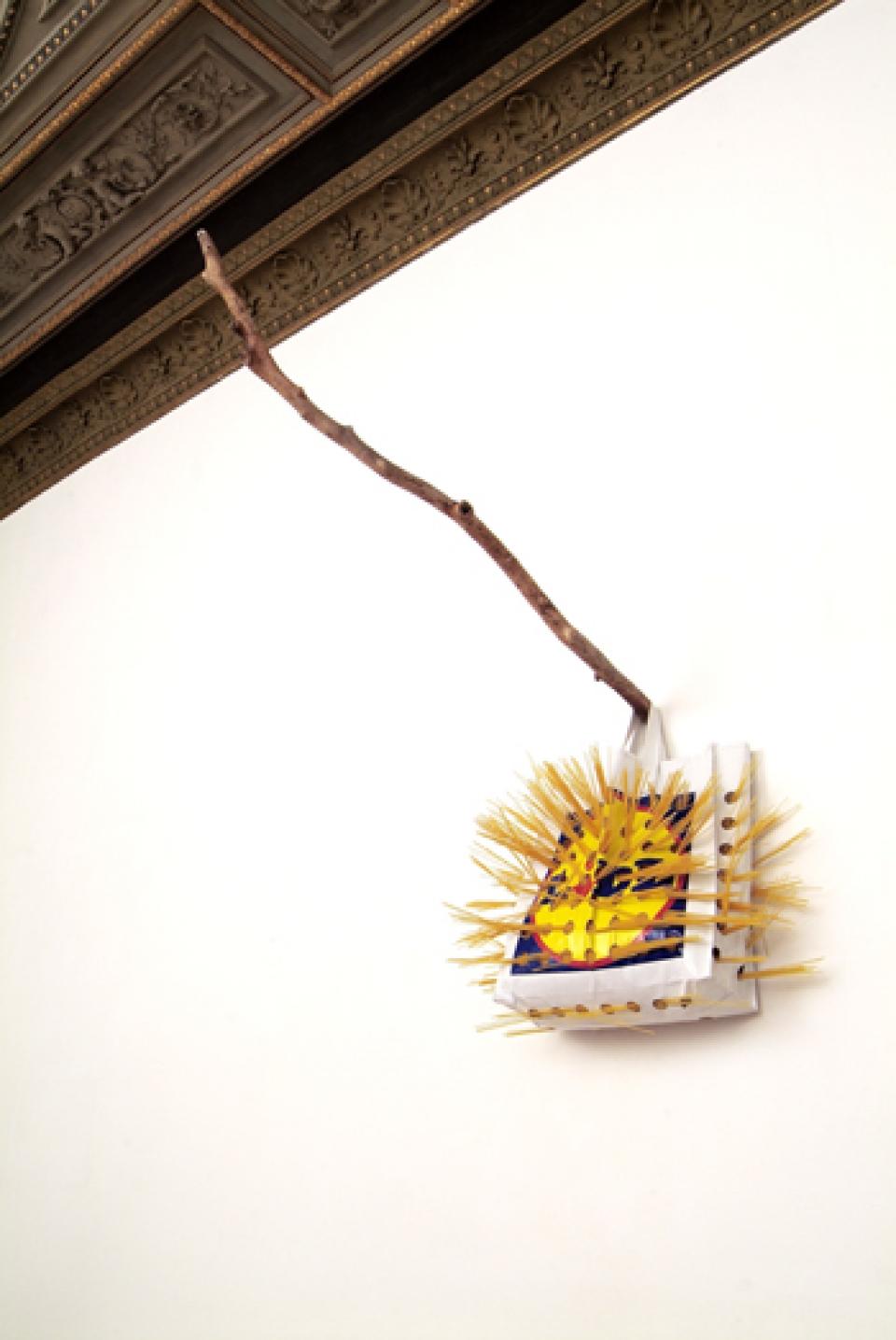
02 // Arbeiten 2007 # 02 Um Himmels Willen
-

02 // Arbeiten 2007 # 02 Kiosk / Heimat 2005/07, PVC corrugated sheet, wood, photography, 50 x 210 x 360 cm
-
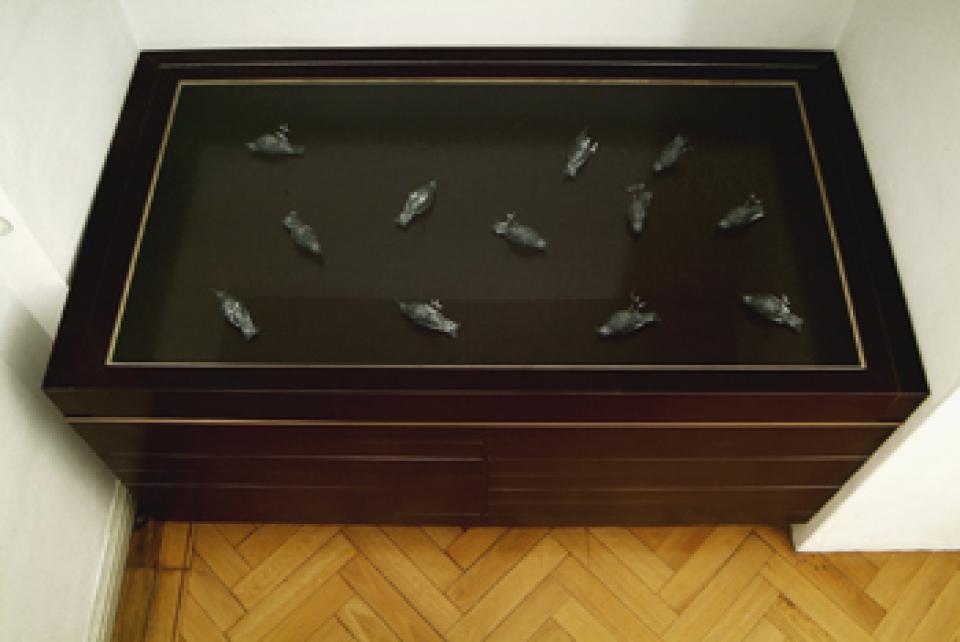
02 // Arbeiten 2007 # 04 Versammlung, paper, size variable
-

02 // Arbeiten 2007 # 05 Vulkanausbruch, mixed media, 200 x 127 x 240 cm
-

02 // Arbeiten 2007 # 07 no title, wooden laths, 88 x 244 x 231 cm
-
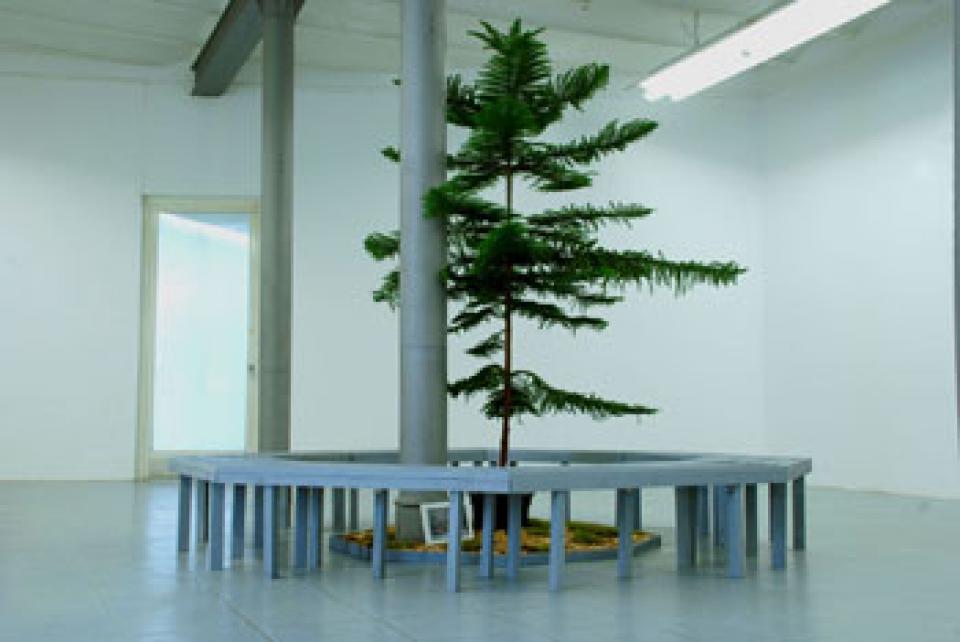
03 // Arbeiten 2008 # 01 Zwei Orte, wood, photo, natural materials, 350 x 350 x 250 cm
-
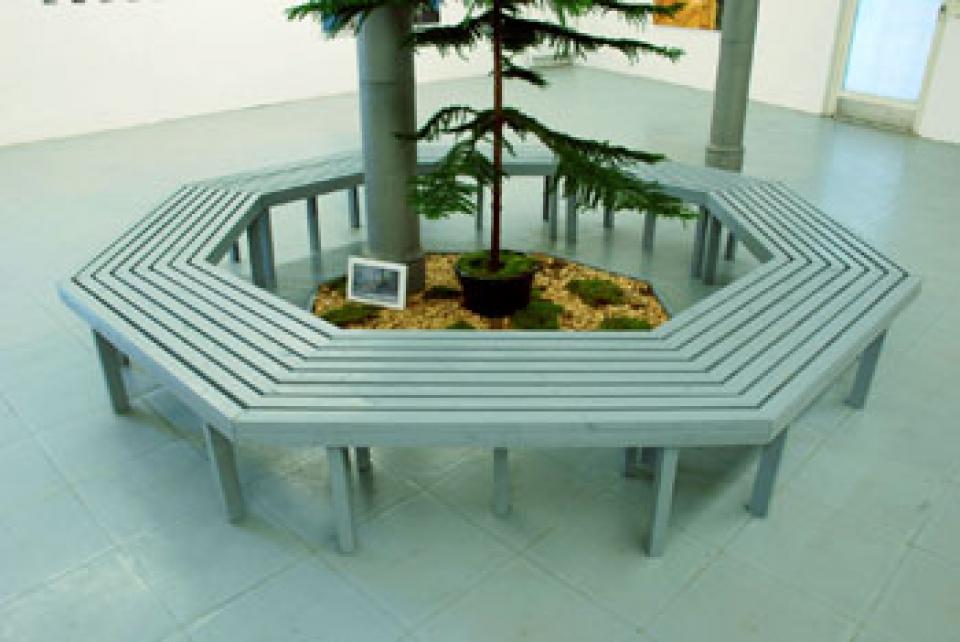
03 // Arbeiten 2008 # 02 Zwei Orte (detail)
-

03 // Arbeiten 2008 # 04 Kiosk/Modell, PVC corrugated sheet, wood, digital picture frame, 50 x 240 x 360 cm
-

03 // Arbeiten 2008 # 06 Kiosk/Modell (detail)
-

03 // Arbeiten 2008 # 07 Kiosk/Modell (detail)
-

04 // Arbeiten 2008/09 # 01 Äste, 2008
-

04 // Arbeiten 2008/09 # 02 Äste, 2008
-
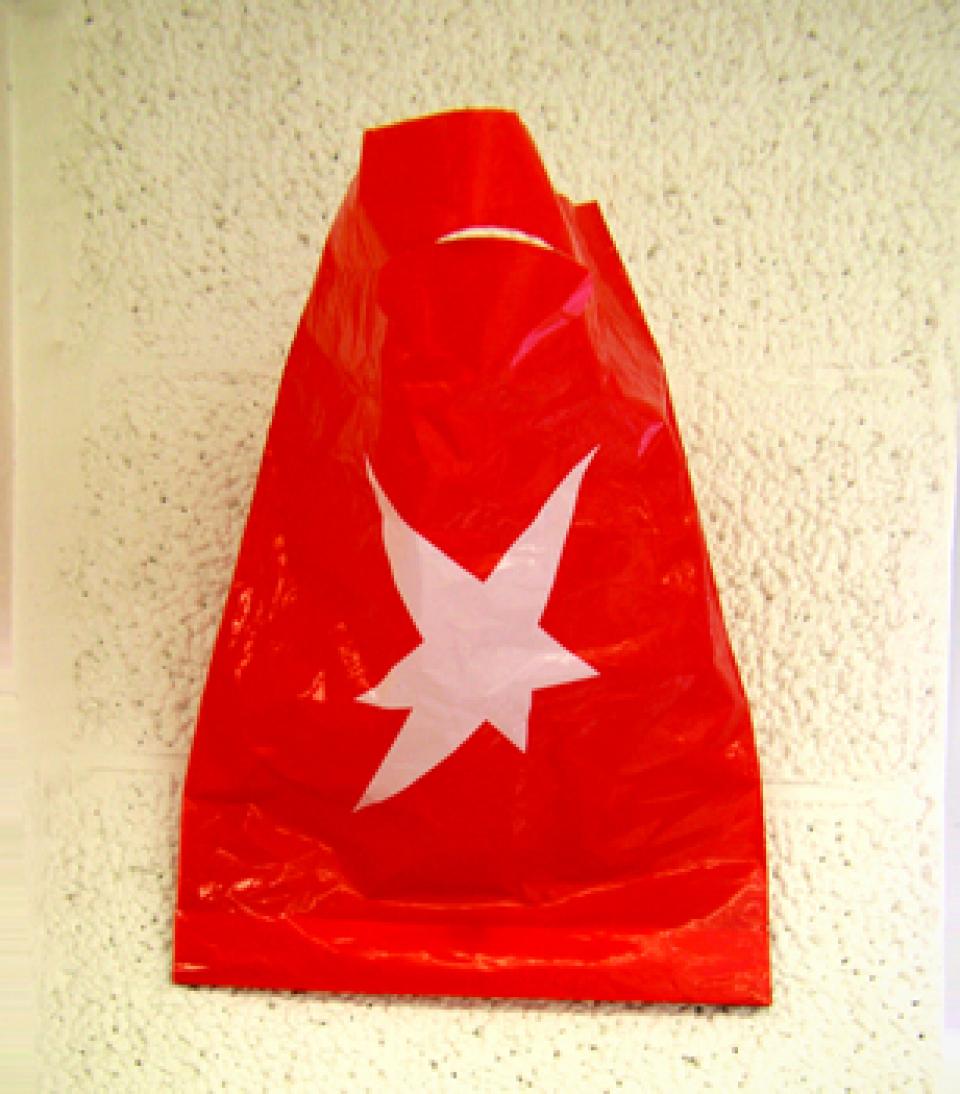
04 // Arbeiten 2008/09 # 03 Stern, 2008
-

04 // Arbeiten 2008/09 # 05 Halle, 2008
-

04 // Arbeiten 2008/09 # 06 Stadion, 2008
-

05 // Arbeiten 2010 # 01 Heute kommt und morgen bleibt , 2010, wall paint, wood, cloth bag, room installation
exhibition: Heute kommt und morgen bleibt | 2010
(Städtische Galerie Bremen) -

05 // Arbeiten 2010 # 02 Heute kommt und morgen bleibt , 2010, Wall paint, wood, cloth bag, room installation
exhibition: Heute kommt und morgen bleibt | 2010
(Städtische Galerie Bremen) -

05 // Arbeiten 2010 # 03 Sonnenfinsternis , 2010, wood, velvet, room installation
-

05 // Arbeiten 2010 # 04 Der kleine Tempel , 2010 , chipboard, lantern, candle, foil, 700 x 250 x 400 cm
-
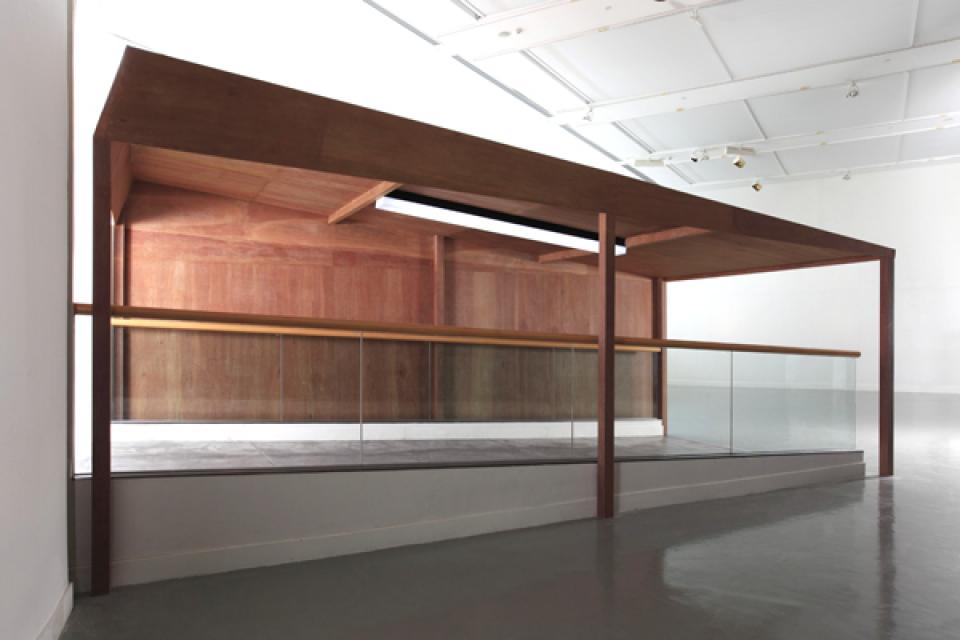
05 // Arbeiten 2010 # 05 Second Class , Second Class, 2010 , wood, artificial lighting, foil, 365 x 760 x 279 cm
-

06 // Pressetexte # 02 Text (engl.) about the work from Preechaya Siripanich, 2008
von Yasin Güzel
(Translation: Philipp Albers):
"The works of Thai artist Preechaya Siripanich explore the tensions between nature and culture, man and city, culture and identity, life and death, wish and reality. He unfolds these topics in narrative installations and architectural miniatures. The meaning of space and architecture are often at the fore of his works of art, reflecting the modern ways of living and the basic conditions of our human existence.
For example, on occasion of an exhibition in one of the multistoried parking garages of the company BrePark (2006), the artist engaged with the site. Using packaging materials such as cardboard, he built a model of such a garage. He contrasts the solid and luxurious building with a plain construction of paper. On the paper roof an ironic label states "Please Remove," basically a superfluous instruction to the consumer. Given the context, the sentence devalues a stony "monstrosity" in the city space and - at the same time - ironically attacks the artist's own artistic practice. Worthlessness, transience, and isolation are constant elements of his work. The cityscape and architectural models are devoid of people, as if these places have been left behind, having become useless. Reasons might be a recession or natural disaster, for example. The work Volcanic Eruption hints at this with its title. The playful architectural forms made of cardboard are covered with white dust, cold snow blanketing everything. A city in decay.
Igloo (2006) also visualizes such deserted spaces and loss: inside the tent are sand, stones, and plants. Nature has taken over culture again after the people's departure. At the same time it represents a basic human situation: to shield himself against the forces of nature, man needs a shelter. He tries to tame nature in a cultural enclosure. Here, the beginning and end of culture meet. People come, people go. The tent is also the form of nomadic dwelling.
The work The Tent (2006) opens a view into an improvised abode made of freezer foil with the logo of the supermarket chain Penny, and in it we can see the most basic belongings of a human being. Someone is still living here. The nomad or derelict uses materials from other contexts to secure his existence. The tent is reminiscent of an emergency shelter, made from waste materials by people in impoverished areas. Another more personal experience of the artist also comes into play here. Siripanich emigrated from Thailand to Germany. After having studied art in Thailand, he attended art school again in Bremen to engage with European art and its traditions. Every migrant knows the feelings of uprooting, an inner homelessness. It is an inner floating between two places that prevents settling down permanently. In Kiosk (2005/08), exhibited in the Städtische Galerie Bremen and the Galerie für Gegenwartskunst, the artist also reflects on this experience. A kiosk is a public meeting place for homeless people, and here it is itself a shack that could be set up elsewhere.
The artist conveys the floating between the present life here and life there especially insistently in the work Two Places (2008). It consists of a bench arranged around a column of the Städtische Galerie. Bark mulch lies on the floor around the column, and there is a Douglas fir. The fir stands in a pot - a miniature park, as it were. Beside the pot there is a photograph depicting a Buddhist meditating on a bench also in front of a landscape of firs in Thailand. Those who notice the photograph will realize that they are engaging in an action similar to the Buddhist. Proximity and a personal connection to the other world of the photograph are created. Siripanich enables the viewer to experience for himself the experience to inwardly live at two places. The fir is also a proxy for Christmas and Christianity. Thus, Two Places also reflects a social reality we might designate as transculture.
It means that cultures always relate to one another and intermingle. They are in constant contact with each other. Globalization and migration only intensified this process. In the installation Äst (2008) the packaging of Asian fast food gets caught in a tree. This could happen in many places in today's world, an effect of the worldwide exchange of goods, food, and consumer products.
The work Samui (2008) addresses the yearning for a homeland or, more generally, the yearning for a different, maybe ideal world. Samui is a Thai island. In front of a suitcase, a guitar, and two palms are three tablets on provisional wood stands. The rays on the middle tablet point to the middle, like a star, which is also a symbol for far-off places and for longing. In this context it can be interpreted as a sign for the human search for a place where one can feel secure. Even if just for a short period of recreation. It calls to mind the nomad - and then the traveler and the tourist, who is also on the go for a limited period of time. Samui is also a popular tourist destination.
Visions and wishes in general are important topics for the artist. There hangs a bag, again with a Star (2008), as a ready-made on the wall. It is a product of the magazine Stern. With its rich connotations of signposts, light, glamorous individuality, and fulfillment, this symbol has been conferred on a simple commodity, a news magazine. Should it promise guidance and light? Advertising attaches an external object to the need for happiness. On the wall the star seems to speak for itself again, indicating a closeness to pop art, which deals with advertising quite critically, partly using consumer goods as material.
In the work For Heaven's Sake (2007) the artist also hints at how advertising appropriates symbols and emotions, and how capital defines life. Namely, the holes in the bag are exactly the size of one-euro coins.
Architecture is another arena for embodying visions. Stadium (2008) is a minimalist and playful work of art. Stadiums are stages for extraordinary stories and events; they are the linchpin of urban visions. Identifying with the athletic successes that take place there, the individual gains a sense of grandeur and power. Here again, the artist works against the structure's monumental meaning by employing transient materials such as cardboard and plywood. The model gives the impression of being unfinished, as if still under construction. In a way the public stadium is provisional like the private tent. Two other architectural models, Hall and Bunker (2008), also belong to this minimalist group of works. In contrast to the open and public Stadium they seem to enclose something private and are evocative of coffins. Their function remains enigmatic.
It may be noted here that architecture, because it is also a refuge, is considered as an extension of the body. In Siripanich's works it is also always to be understood as a symbol of the perishable human being and his perishable culture. Memento mori are a constant motif in the sculptures and installations. Gathering (2007) assembles dead birds, starlings, made of paper in a display cabinet as in a coffin. A dreadful, apocalyptic idea. By all means can it be interpreted as a parable of the situation of art. The desire for fame, the want to rise above the circumstances, at which the starling hints, finds its remorseless end in death. Dead is dead. That is where life comes to a head. Thus, in Morning on the Terrace (2007) another dead bird lays in the corner of a triangular balcony. Death looms everywhere, even in the abstract repository of culture. It can rise against nature but cannot transcend this boundary.
Siripanich very clearly investigates the relationship between culture and nature. Encountering dead animals on the street or in the home is not uncommon. They are in part the victims of civilization. The installation Magpie (2007) poetically and buoyantly sheds light on the interrelation between nature and city. A bicycle covered with a blanket thereby receives a skin, a body. In contrast, the magpie as a living animal is formed as a word and introduced as a cultural, abstract existence. At the same time the sequence of letters could be a view of the city from above. Or roadways, on which the bicycle and the bird move. The artist transfigures the machine into nature and translates the animal into culture. The boundaries between the two blur, and they form a whole.
The artist from Thailand explores cultural processes in his own special way. Given his background, he deals with the relationship of Asian and Western culture and in his artistic work fuses forms and ideas from both worlds. He himself has been shaped by Buddhism, which also in part defines the contents of his works and explains his affinity to minimalism. His works emphasize the changes, the transience, and evanescence of life. Advertising as well is just superficial information, which we briefly absorb and then forget. In the end, nothing remains for us personally. We are all travelers and wanderers. Our body is only a provisional packaging for our soul and spirit. Particularly in view of death, our drives and wishes are important, guiding powers for the creation of meaning and identity. Siripanich examines how these powers shape our urban environment. How the concrete acts in the abstract, or how nature acts in culture."
-

06 // Pressetexte # 03 solo exhibition in the Galerie für Gegenwartskunst, 2007
Speech at the opening of the exhibition in the Galerie für Gegenwartskunst, Bremen
Barbara Claassen-Schmal, gallerist:
"This is the first solo exhibition of the Thai artist Preechaya Siripanich.
He used the gallery rooms as a studio for a few weeks. Almost all of the various installations were created on site.
Previously, Preechaya Siripanich could be met at the Hochschule für Künste, where he graduated in 2006 as a master student of Yuji Takeoka.
There, the table was created from utopian mega-cities for which the artist had constructively altered colored packaging boxes and provided them with openings. Seemingly functional buildings such as gas stations, silos, and factories formed a spatial ensemble.
These territories were not living spaces for people, but rather production and economic spaces that radiated a certain cheerfulness because, referring to Warhol, they carried all the colourful product labels that encouraged consumers to buy.
These installations of empty enclosures were reminiscent of urban regions that seemed to have lost their function, or perhaps never had real functions.
The exemplary scale of these topographical ensembles was lost when oat flakes were actually poured out of Kellogg's packages or lump sugar slipped out of other packaging.
The city utopia in the exhibition drives this puzzle even further. Like after a volcanic eruption or a sudden snow catastrophe, everything is covered in white powder. The unspoiled nature of the scene associates the idea of a stretched moment, time seems to stand still. And yet this state does not seem to extend indefinitely into the future.
Everything is in an open, latent stage, nothing is as it seems, the visible is not necessarily the true. The oversized lantern is more irritating than illuminating the situation, and as soon as a storm sweeps over the city, everything could change again.
The kiosk in this exhibition has changed its appearance, it was once equipped with shelves and goods like an actual shop. Undressed from all this, reduced to the architectural form, the viewer only finds one photograph in the building. It shows a small temple in front of which a Buddhist monk sits. This photograph is the only reference to Thailand, the home of the artist. This photograph is the starting point of the exhibition.
The photograph was taken in 2003 when Preechaya Siripanich went to a monastery in Thailand for 6 weeks. When he talks about it today, then the strangeness in this situation predominates in his memory: the daily routine was unfamiliar, his feet ached from walking on perennial feet, begging for food was strange, he had to do without his own money, Buddhist prayer was unfamiliar, etc. These experiences describe the distance that had developed to his homeland in the meantime.
Artists like Preechaya Siripanich are confronted with the need to take up the foreign culture of new living spaces and to place it in dialogue with their own tradition.
The accompanying loss of cultural identity creates, one could say, "interspaces" in which various spheres of influence begin to overlap and mix. The Preechaya Siripanich kiosk is an example of this.
In such intermediate zones, the formerly separate territories of life, recombinations and zones of ambiguity arise in addition to mixtures and superimpositions, Salman Rushdie coined the term "bastarization" in this context.
The increased attention paid to cultural transfers of this kind are manifestations of globalization that have long since reached contemporary art. The results of cultural mixing, however, do not necessarily have to be imagined as peaceful multicultural coexistence of the former foreign. The decisive factors are rather the untranslatability of humour, which can be found in any culture and which ultimately remain resistant and make exhibitions like these so interesting". -

06 // Pressetexte # 04 Protokolle des Absurden, 2007
Rainer B. Schossig, culture journalist:
"Multicultural, my ass! The Nigerian exhibition organizer Okwui Enwesor has made it clear to the rest of the world with his "Documenta 11" that even the aesthetic clash of cultures can be not only cheerful and painless, but serious and full of dreariness. Since then, more and more hybrid artist existences have entered our Eurocentric field of vision. Barbara Claassen-Schmal now presents Preechaya Siripanich, a Thai artist who has lived in Europe since 2000 and studied sculpture with Yuji Takeoka in Bremen, in her "Bremen Gallery for Contemporary Art".
Migrant atmosphere in the Altbremer Haus: a Lidl plastic bag with euro-sized holes on the wall of a knot stick, from which lots of spaghetti protrude; in front of it a kind of playpen with colourful little houses made of cardboard boxes, all covered with white lime, illuminated by a giant street lantern made of drainage pipe with cellar light. Next: an empty kiosk made of corrugated iron and plywood, in which only one photograph of the artist is exhibited, showing him meditating in a Buddhist monastery, opposite a glittering triangular aluminium balcony with a dead paper star on it. Preechaya Siripanich, born in 1973 in Saraburi, Thailand, has also built igloos from tarpaulins for brackish water biotopes or a winter-proof accommodation from thermo bags for tramps.
Are these everyday replicas or utopian models, projects or protocols of the absurd, toys or allegories?
It is all about home and refuge, dwelling and strangers. Preechaya Siripanich's installations of recyclable and bulky waste finds, of precisely processed DIY store semi-finished products or packaging materials programmatically settle in the cavities and interstices, the unplaces, the blind spots and flaws of global civilization. His creativity lives from our misunderstandings about the supposedly "exotic" of the Far East.
What we find strange is familiar to the guest from Thailand, and he becomes a parable, which we don't even notice anymore because of his "normality": Something when he puts a black motorcycle cover, which he has painted on a white field, over a bicycle. Finished is a wrinkly, melancholic sculpture, entitled "Elster". A dozen dead paper starwheels lie next to it in the showcase. One leaves the house in a thoughtful, poetic mood. Multicultural, my ass..." -
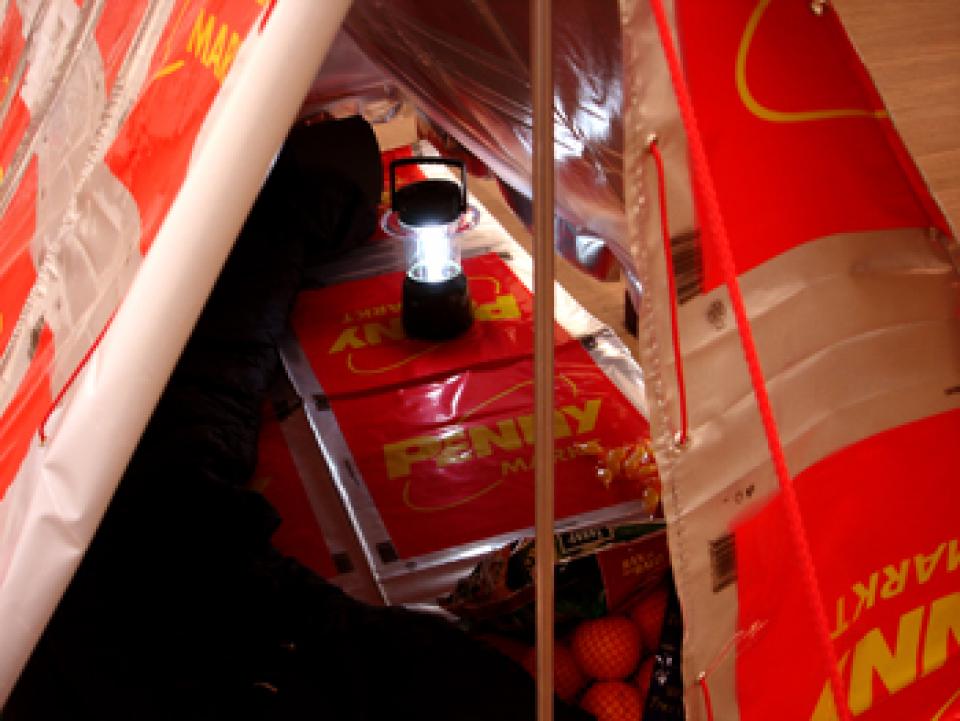
06 // Pressetexte # 05 Text über die Arbeit "Das Zelt", 2008
Stefanie Böttcher, curator, Bremen:
"The works of Preechaya Siripanich are foreign bodies in a familiar world. The Thai artist combines familiar objects, materials and images into bizarre constellations, placing them in new contexts. In addition to the visual impression, his works also emit olfactory stimuli. Thus, Zelt (2006/08) consists of freezer bags with the radiant, widely visible Penny lettering that join together to form a travel tent. This temporary dwelling, which also stands for a nomadic existence, is located in the middle of a whitewashed area with numerous shoe prints. The scent the material exudes reveals it as washing powder. Thus we become aware that it is not snow, but at the same time an atmosphere unfolds that resembles that in a snow-covered landscape: Freshness and coolness fill the room. In the tent we find few legacies, a private space that contains so little personal stuff. A place whose artificiality signals strangeness, the clash of diverse cultural goods, which ultimately also stands for uprootedness and isolation".